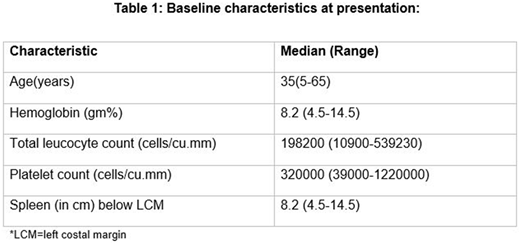Abstract
Background:
Presence of myelofibrosis on bone marrow examination is considered as poor prognostic factor in patients with chronic myelogenous leukemia (CML). Scant data is available on myelofibrosis, especially in the era of tyrosine kinase therapy. The present study was designed to analyze impact of myelofibrosis on outcomes in newly diagnosed patients with chronic myeloid leukemia in chronic phase (CML-CP).
Aims and objectives:
The primary objective of this analysis was to study event free survival (EFS) and major molecular response rates (MMR) at one year in patients with CML-CP with myelofibrosis.
Secondary objectives were to study the parameters impacting outcomes in patients with CML-CP with myelofibrosis
Materials and methods:
Study period: 2010 to 2016
Type of study: retrospective analysis.
The diagnosis of CML-CP was done by demonstration of BCR-ABL translocation by polymerase chain reaction or fluorescence in situ hybridization. Event free survival was defined as the time from start of therapy to death, transformation to accelerated or blast phase, hematologic resistance or toxicity intolerance. Statistical analysis was done using SPSS software, version 25. Overall survival curves were plotted using the Kaplan-Meier method. Grade of myelofibrosis, EUTOS risk, age and compliance were analyzed on multivariate analyses.
Results:
Data of 147 patients with CML-CP with myelofibrosis at presentation was retrospectively collected, of which 79(53.7%) were males and 68(46.3%) were females. The baseline characters were tabulated in Table 1. Abdominal fullness (60.5%) was the most common symptom at presentation followed by fatigue (48.9%), weight loss (36.7%), fever (25.1%) and bleeding manifestations (12.9%). EUTOS risk was low in 94(64%) patients and high in 53 (36%) patients. Myelofibrosis grade 1, 2, 3 and 4 were seen in 20(13.6%), 36(24.5%), 38(25.9%) and 27(18.3%) patients respectively. Grade of myelofibrosis was not available in 26(17.7%) patients.
Of 147 patients, outcome parameters were available in 92 patients. Of 92 patients, 34(37%) attained MMR at 1 year. At a median follow up of 46 months, event free survival was 60.9%. Of 92 patients, MMR at one year differed significantly in patients with grade 1 and 2 myelofibrosis (48.8%) compared to patients with grade 3 and 4 myelofibrosis (26.5%) (p=0.02). Event free survival was higher in patients with grade 1 and 2 myelofibrosis (76.7%) compared to patients with grade 3 and 4 myelofibrosis (46.9%) (p=0.005). Drug induced myelosuppression was seen in 27(29.3%) patients, of which 7(26%) patients received dose reduction. Phase transformation was seen in 6 patients, of which 1(16.7%) and 5(83.3%) patients were transformed to accelerated phase and blastic phase respectively. On multivariate analysis, only grade of myelofibrosis had significant impact on event free survival(p=0.013).
Conclusion:
In patients with newly diagnosed CML-CP, major molecular response was significantly lower for those with higher grade of myelofibrosis. Grade of myelofibrosis at presentation had significant impact on outcomes in CML-CP. Hence, bone marrow examination for presence and grade of myelofibrosis helps in prognosticating CML-CP patients.
No relevant conflicts of interest to declare.
Author notes
Asterisk with author names denotes non-ASH members.


This feature is available to Subscribers Only
Sign In or Create an Account Close Modal